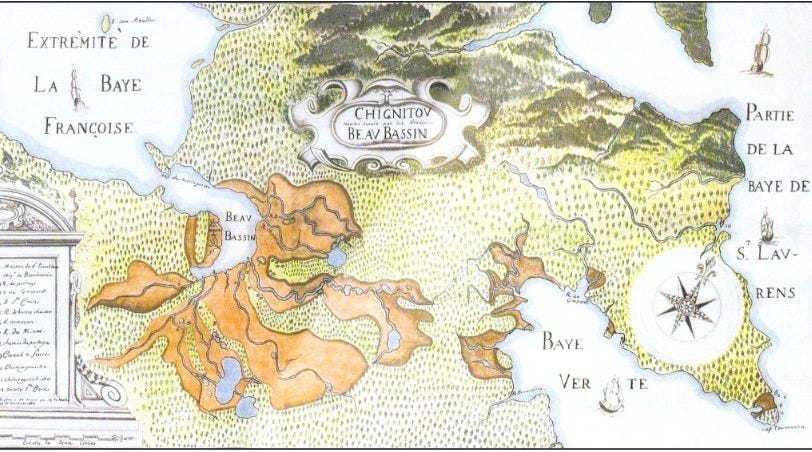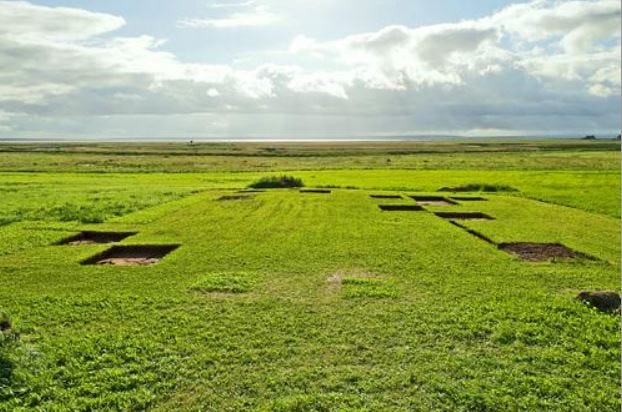
This post is for the readers who made this long journey with me. What follows is an account of what happened to the people of Beaubassin and their village. The sad tale of the exiled Morins has yet another twist to it.
The final installment may be found here:
The Morins eventually found a permanent home in Montmagny, on the southern bank of the St. Lawrence, a small distance down river from Quebec. For a while, they still had the vain hope of returning. Pierre’s widow Marie did not renounce her land grant in Beaubassin until 1702.
Two years after the expulsion of the Morins, French and native war parties attacked the English in Maine and New Hampshire as reprisal against English raids. The English responded in turn with an attack on Port-Royal in May of 1690. Abbé Trouvé happened to be in Port-Royal as a guest of Governor de Meneval when he and Meneval were taken captive.
Trouvé was transported to Boston and remained prisoner of the English for six months. He was only released after William Phip’s unsuccessful attack on Quebec resulted in a prisoner exchange that autumn, orchestrated by his old partner in crime, Michel Le Neuf. Trouvé remained in Quebec, where his mentor Bishop Saint-Vallier named him an ecclesiastical superior of the Ursuline monastery. He eventually returned to his missionary work in Beaubassin.1
Trouvé was still in Beaubassin when Colonel Benjamin Church led four hundred Englishmen and Iroquois in a raid on Chignecto in 1696. The English killed villagers, looted and burned their homes, and slaughtered their animals. Church said he would return, and followed through on his threat eight years later. This time, the inhabitants were warned the English were coming. Trouvé was among the organizers of an evacuation of the villagers with their belongings and a few of their animals.
The people of Beaubassin trekked several weeks until they reached Fort Louis in Chedabucto (present day Guysborough, Nova Scotia). After accompanying his parishioners to safety, Trouvé allegedly died of exhaustion at the fort in 1704. In this second raid on Beaubassin the English destroyed the dykes that held back the marsh, slaughtered the villagers’ cattle, and burned Michel Le Neuf’s manor house on Ile de la Vallière.

Michel Le Neuf was not in Beaubassin at the time of the attacks in 1696 or 1704. In 1696, he and his son Alexandre were at sea, defending the Atlantic Coast of Acadia from English ships.
Ever failing upwards, Le Neuf was appointed Mayor of Montreal in 1699. When he the found himself in financial difficulty, Le Neuf was set up with a porpoise fishing concession. He never followed through on that business. He formally ceded his seigneurie to his children in 1701 and never returned to Chignecto.
In 1704, during Church’s second raid, Le Neuf was sailing to France to get the formal decree that would ratify his family’s claim on the seigneurie.2 While in France he received the title Chevalier de Saint Louis. He died at sea on his return voyage to New France in 1705.3
Le Neuf succeeded in making advantageous matches for his daughters. In the spring of 1692, his younger daughter Judith married Beaubassin’s one-time temporary seigneur Claude-Sébastien de Villieu. Later that year, Louis Morin’s sweetheart Marie-Josephe Le Neuf married Jean Legardeur de Saint-Pierre, an officer in the colonial army, explorer, and fur trader, with a distinguished career as an interpreter and diplomat among the native peoples. She had five children with him before she died at the age of 35 in 1704. There is no record what became of her baby with Louis Morin.
Pierre Morin’s oldest son Pierre and his wife Françoise went on to have more children in their new home in Montmagny. Their ninth child, Antoine, was born in 1704. Antoine and his son farmed in St-François-de-la-Rivière-du-Sud. In the early 19th century Antoine’s grandson, Louis-Joseph Morin, returned to his family’s original place of exile, the Baie des Chaleurs, settling in the village of Port-Daniel. Louis-Joseph Morin is my fourth great-grandfather.
The Morins lost everything when they were expelled from Beaubassin. But as a result of their expulsion they were spared what happened next.
The people rebuilt after the devastating raids of 1696 and 1704. Beaubassin became a site of great strategic importance for the French in North America following the Peace of Utrecht, which made it the dividing line between the English and the French.
In 1750, the town of Beaubassin was put to death on the orders of the French crown. Its 2,800 inhabitants evacuated across the Missaguash River to Fort Beauséjour so that the town could be torched and razed to the ground before it was captured by the advancing British.
Five years later, Fort Beauséjour was the site of one of the worst episodes of ethnic cleansing in the colonial wars, in which Acadian French civilians, believed to be a security risk to the English, were subject to deadly deportations to places as far away as Georgia and Louisiana.
The Acadian Memorial List seeks to document the many thousands of victims of the Grand Dérangement, identifying the names of Acadians who died far from home, many lost at sea.4 This list, linked below, has some familiar surnames for readers of this tale:
Bourgeois
Kessy
Chiasson
Cormier
Cyr
Haché
Martin
Pellerin
Poirier
We remember them.
Nature has since reclaimed Beaubassin, which is once again a salt marsh and a national park.
Many thanks to Gary Tucker for the use of his sublime photographs of the marsh surrounding the historic site of Beaubassin. If you wish to see more of his extraordinary work, or order a print, his website may be found here: https://garytuckerphoto.com/
Baillargeon, Noel, “TROUVÉ, CLAUDE,” in Dictionary of Canadian Biography, vol. 2, University of Toronto/Université Laval, 2003–, accessed June 30, 2025, https://www.biographi.ca/en/bio/trouve_claude_2E.html.
As we know from Part 5, Le Neuf did not receive the formal decree that confirmed his legal claim to his seigneurie. He had to go to France to obtain it.
Comeau, J-Roger, “LENEUF DE LA VALLIÈRE DE BEAUBASSIN, MICHEL (d. 1705),” in Dictionary of Canadian Biography, vol. 2, University of Toronto/Université Laval, 2003–, accessed June 30, 2025, https://www.biographi.ca/en/bio/leneuf_de_la_valliere_de_beaubassin_michel_1705_2E.html
Acadian Expulsion Memorial List https://www.wikitree.com/wiki/Category:Acadians_on_the_Nicole_Nunes_Acadians_Memorial_List








Ethnic cleansing is exactly the right term.
Great story! I couldn't wait to see what happened in the next episode! Very well-written. I love the way you took the facts and used them to bring out the people's personalities.